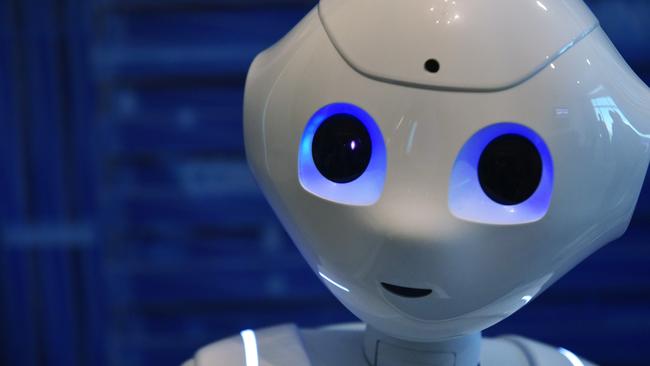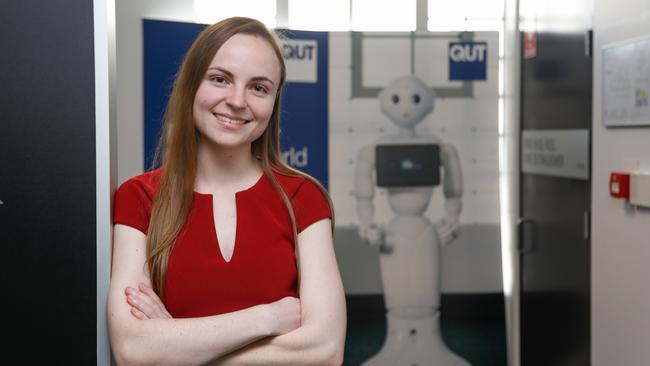The droid will see you now
Are you ready to take health advice from a robot? Trials are under way in which robots interact with patients in hospitals.

Get ready for robots interviewing you in clinics and hospitals, offering health advice and even criticising your bad health habits.
It’s early days, but social robots are making their mark in the health sector. Tests of socially equipped robots have taken place in medical facilities in the US, Europe, Japan and Australia.
These robots not only hold a basic conversation, they try to connect with you emotionally, using eye contact and in some cases sensors to gauge your mood.
They might answer your questions, give you a health assessment and some timely lifestyle advice.
They cost tens of thousands of dollars but, with mass production, robots will be become more affordable. And the business case for their use is solid.
Conducting a health survey with a new patient, answering routine questions such as where to buy a coffee or where visitors can park, and providing information about stopping smoking, avoiding the flu and improving nutrition soak up the time of health professionals. A social robot can relieve a nurse of some of these duties.
Trials are under way in which robots interact with patients in hospitals and clinics.
Hospitals in Texas last year trialled a four-wheeled robot called Moxi, which interacted with staff and patients, collected medical supplies and took them to doctors and nurses.
In Europe, Belgium company ZoraBots sells social robot software for healthcare that can be loaded into the NAO and Pepper humanoid robots developed by Japan’s SoftBank Robotics.
In Australia, the ARC Centre of Excellence for Robotic Vision has been hosting trials of social robots at Townsville Hospital and at Queensland University of Technology. It has adapted SoftBank’s interactive human-looking robot Pepper. SoftBank released it in 2015 and more than 2000 companies have adopted it around the world. In many cases Pepper is a concierge, answering questions and offering information in shopping centres, foyers, banks, schools, universities and homes.

Through the years Pepper has evolved as an all-purpose social robot that can be tailored to specific tasks with specialist software.
It communicates by speech and via a touchscreen in 15 languages. It has a head with 20 degrees of freedom to emulate natural movement, a “perception module” for interacting with others, and touch sensors, LEDs, microphones, infra-red sensors, bumpers, an inertial unit, 2D and 3D cameras, and sonars. Pepper is programmable, so it can be adapted to different tasks and environments.
Townsville Hospital nurse Anne Elvin says the study was conducted with James Cook University and fellow nurses.
In July and August last year, Pepper was placed in the corner of a 16-bed emergency ward.
“We had her stand as a concierge. The robot answered questions that nurses frequently were asked but didn’t have time to answer … Things like: How do I get a coffee? How do I get out of here? Where are the exits? How do I pay for parking?” says Elvin.
The robot was fixed and couldn’t move, for safety reasons. Trigger zones were set up so Pepper noticed people walking by and greeted them. The robot’s software did not access Wi-Fi, to avoid it being hacked remotely.
“People would ask: ‘Where can I get a smoke?’, and Pepper would respond with: ‘Smoking is not allowed on the Townsville hospital campus.’ She would also then go into a spiel about how you can quit smoking while you’re here.”
The robot was then placed in the hospital’s main foyer from September to December. It was programmed to ask people about whether they had a flu shot, their attitudes towards vaccination and washing their hands to avoid disease. People replied using Pepper’s touch screen and their responses were collected. The robot would offer advice on these.
The studies explored the usability and acceptability of robots in health, and whether it could improve people’s health literacy.
Elvin says Pepper put smiles on people’s faces but they also saw the robot’s therapeutic value.
Clinicians brought their ideas on how they could use a robot, such as providing detailed dietary information and conducting preliminary health questionnaires that were passed to doctors.
“We saw potential in having the robot talk to clients who were reluctant to talk to physicians. We saw potential in clients wanting to talk to the robot because it wasn't a human. And they felt it possibly was non-judgmental,” Elvin says.

“We saw potential in seeing clients that were proactive in their own health and wanting to get information from a source they could readily approach without having to make an appointment.
“We found clients who were happy to talk to a robot for extended periods because they trusted the information being given by the machine. They accepted criticism by robots.”
Separate trials took place at QUT. For about four months, people could book an appointment with Pepper to do a health survey that was passed to their clinician, QUT Health Clinics manager Lisa Morgan says. The survey included information about sleeping habits, diet and activity. Patients were given a printout of collected data.
Social robots also can alleviate some of the pressures that health centres increasingly will be experiencing.
“There's going to be increasing pressure across all healthcare services, with people becoming more aged. There are going to be increases in chronic diseases, and that's going to create workforce challenges to meet those demands,” Morgan says.
“So health robotics will be part of the future solutions to help provide healthcare in a way that’s about working smarter, not harder, to deal with those demands.”
Hospital robots are likely to converse casually with patients in the future and act as company for the young and elderly.
“I can see this being used with young children as a way to engage them in healthcare practice, doing it in a way that’s really fun and interactive for them. The sky’s the limit on what a robot could potentially be programmed to do in future,” says Nicole Robinson, research fellow at Australian Centre for Robotic Vision.
“If you're not feeling comfortable enough to speak to someone in person, you might potentially feel a bit more comfortable talking to a robot.
“In rehabilitation, you could have a robot train with you, alongside you, as you're doing the techniques. It’s a coach, a therapist, a companion, a rehearsal tool.
“There are so many ways you could repurpose a robot to target such a broad spectrum of health behaviours, but I definitely see a lot of one-on-one interaction with a robot and a person.
“Computer vision in robots might monitor if people are taking their medication, if they are in distress or had fallen over, or in the wrong area of a hospital ward.”
Robots might devise a personalised healthcare plan and offer therapeutic support to patients.
Robots are unlikely to take over nursing functions but will provide consultation support and deal with administrative issues.
“You won’t see Pepper trying to take someone’s blood pressure any time soon but you just might see Pepper talking to someone about their blood pressure results,” Robinson says.
“We will never see a doctorless hospital, we need doctors, and we need nurses to care for people.”


